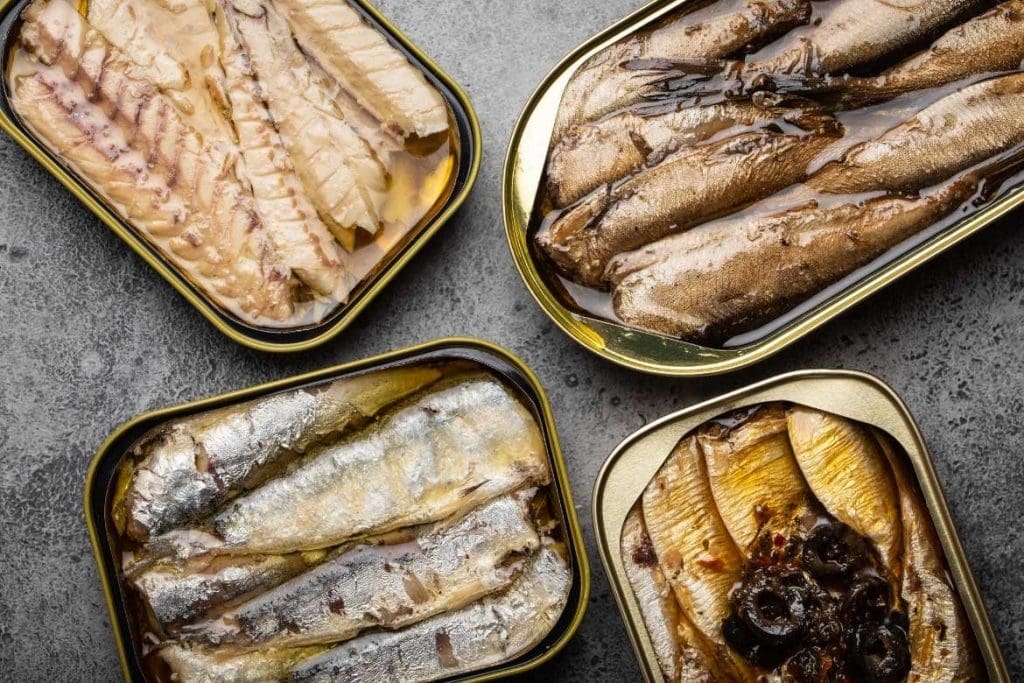Canned sardines in Portugal. More than half of the brands are of very good quality. So they are worth to try while visiting.
The Portuguese are increasingly buying canned sardines: with sales increasing by 12% a year, sardines in olive oil have become a trend in recent years. This growth is in line with the increase in demand for canned food in general. In 2022, sales of canned fish reached 185,000 tons, an increase of 7% per year.
Canned fish is practical and can be stored for a long time in optimal conditions. It is this good state of preservation of sardines – the most sought-after after canned tuna, the undisputed leader in the segment with an 85% share – that DECO PROteste’s analysis of 18 brands on sale shows. Samples of whole canned sardines were tested, without heads or entrails.
The test revealed problems in some cans and samples that contained higher water residues. In the sensory analysis, most passed with flying colors, but texture and/or oxidation prevented some from doing better.
The best sardines in olive oil
The results are quite positive: correct net weight indicated, no excessive salt and samples with no microbiological issues. Generally speaking, the packaging didn’t show any problems either, although cans were found with microcracks, which could jeopardize the integrity of the product.
There are a few things to bear in mind when choosing canned food. The packaging must be in perfect condition, so that the can guarantees the safety of the food in different storage conditions, in commerce and by the consumer. The examination of the packaging was carried out on five units from each batch, taking into account factors such as signs of increased volume, dents, corrosion and sealing defects.
As for the interior, in addition to the visual inspection for stains, varnish defects and corrosion, a spot check was carried out to check for microcracks. Most of the samples gave very good results. Occasionally, small dents and/or a slight crimp appeared near the crimping, but these were of no importance. Two samples, however, had units with microcracks on the weakening line, which could jeopardize the integrity of the product.
Another criterion was to determine the total net weight and the drained net weight, i.e. the amount of fish without the covering sauce. A comparison of the values indicated on the packaging with those obtained in laboratory tests on ten packs of fish was made.
Less salt in canned sardines
Even in slightly higher quantities, the presence of water in the covering medium (it was found to be olive oil from the fatty acid profile) is not usually associated with an intentional addition. It is usually related to the raw material and aspects of the manufacturing process, such as the water given off by the fish during heat treatment. The values obtained from the cans, expressed as a percentage of aqueous residue in relation to the total net weight, varied between 3 and 8.8 percent. Most brands received good marks. The exceptions were Continente and Dorita, with a watery residue of more than 8%, the maximum value taken as a reference.
Salt is another thorn in the side of canned sardines. Considered one of the culprits for increased blood pressure, stomach cancer and cardiovascular problems, among other ailments, this ingredient requires a moderate intake, with the World Health Organization recommending that the daily intake should not exceed five grams for an adult. Minerva has revealed a salt content of less than 0.5 percent.
Really good sardines
With a few bones along the way, we come to the important sensory analysis, carried out by specialists trained in the sensory analysis of fish. The test included a visual and olfactory examination and a tasting: the cans were opened immediately before the evaluation.
The results were positive: all the brands presented the fish well arranged in the can, of uniform size, easily separable, well headed, without a tail fin, or ruptures (abdominal wall and/or muscle) or foreign bodies, and mostly without viscera. But there were also less positive ones. These were mainly due to the soft or fibrous texture, aroma and taste of oxidized or fermented fish. In the Socilink product, there was widespread oxidation and sometimes a darker color.
The best fish each month
Which endangered species should be highlighted? Choose the category and the fish and discover the ideal month to enjoy it.
Variety is the golden rule when it comes to eating fish. To ensure less exposure to certain contaminants, better nutrition and the sustainability of species, the key is to vary. We want to continue eating fish like our sardines, a species that is almost threatened. Fresh sardines should be eaten between July and December, outside the breeding season and with enough time to fatten up and be at their best. Another precaution is not to buy small fish, below the minimum catch defined by law. To continue eating fish sustainably, consult the guide and see the period for each species.
Related article: These Portuguese fish cans are some of the world’s best
Why Sardines are the Symbol of Portugal’s Culture and Cuisine

